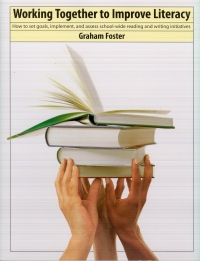| ________________
CM . . .
. Volume XV Number 18. . . .May 1, 2009 
 |
Working Together to Improve Literacy: How to Set Goals, Implement, and Assess School-Wide Reading and Writing Initiatives.
Graham Foster.
Markham, ON: Pembroke, 2008.
109 pp., pbk., $24.95.
ISBN 978-1-55138-224-1.
Subject Headings:
Literacy-Study and teaching.
Language arts (Secondary)-Ontario.
Professional.
Review by Gregory Bryan.
**½ /4
|
| |
|

excerpt:
Two main motivators underlie collaborative literacy programs. By working together to enhance their school literacy instruction and by ensuring best practice in program coordination, teachers enjoy professional affirmation. At the same time, they enhance their students' language learning and their school's overall success.
Graham Foster is a private consultant who works with schools on collaborative literacy projects. Foster has penned a number of professional texts for Pembroke Publishing. Foster's latest text is Working Together to Improve Literacy: How to Set Goals, Implement, and Assess School-wide Reading and Writing Initiatives. Six chapters and 109 pages in length, the book is presented as a resource for school administrators and literacy coaches involved in school reform that aims to improve student reading and writing.
From the outset, Foster emphasizes a "spirit of collaboration" in school-wide literacy initiatives. He writes that working hard is not enough to improve instruction. Rather, Foster believes teachers need to work together. It is a good starting point, and Foster remains true to this ideal throughout his book. The author describes the purpose of the text as being to "describe a specific process for collegial engagement in goal setting, implementation, and assessment geared to collaborative literacy instruction." It is an important aim, and the book will prove a useful resource for many who are involved in school reform. I do think, however, that the book is generally too simplistic and formulaic. Successful professional development and school reform cannot be achieved by adhering to a series of checklists, and readers need not think that this book will satisfy all of their needs or answer all of their questions.
Given the target audience, one of the most attractive features of Working Together to Improve Literacy is the practical nature of the book. It contains a number of reproducible forms, graphic organizers and checklists that will prove useful. Foster also emphasizes that the book content is based mainly on the author's personal observations and experiences. This focus does, however, come at a cost. The professional literature on the topic receives only a cursory glance. For instance, Michael Fullan is one of the most respected professional voices in the area of school reform, yet only one Fullan resource is cited in Foster's work. There is no reference at all to the work of Etienne Wenger or Jean Lave and their "communities of practice." Throughout the book, Foster seems not only to ignore too many respected voices from the professional literature, but he seems also to rely too heavily on a select few. For instance, when talking about writing instruction and improvement, Foster relies almost exclusively on the work of George Hillocks. Furthermore, the two Hillocks sources cited are dated. The most often cited source is from 1986. Has nothing of value been published in the field of writing education in the past 20 years? In focusing so much on Hillocks, Foster omits possible additional or alternate references to the work of writing authorities such as Donald Graves, Nancy Atwell and Lucy McCormick Calkins, to name but a few. For me, these points tend to discredit some of the material. An over-reliance on a few sources does not reflect thorough scholarship or deep awareness of the subject. I also noticed that, of just 27 sources included amongst the references, four are Foster's own work (15%). Twelve of the references are Pembroke/Stenhouse publications (44%). While this bias is understandable from an economics point of view, the validity of a publication is called into question when issues of self-promotion threaten to stand in the way of scholarship.
Among the highlights of the text, Foster includes advice regarding such things as inviting support for, and involvement in, school reform. He also discusses positive ways to respond to naysayers. In Chapter 2, Foster stresses that professional development should be viewed as a focus upon students' needs, rather than upon teachers' weaknesses or shortcomings. This point is supported in Chapter 4 when Foster writes that assessment data should be used to measure the effectiveness of a programme, rather than being a measure of a teacher's ability or performance. In these ways, the tone of Foster's work is generally appealing, encouraging and supportive.
The practical suggestions in Working Together to Improve Literacy will assist many literacy leaders. I appreciate the esteem with which Foster views teachers. Insofar as improving student learning is concerned, Foster considers teachers to be a school's most valuable resource. While teachers remain the most valuable resource, I do think that many teachers and their school leaders will also find Working Together to Improve Literacy to be a valuable resource. Despite some shortcomings, there is much here that is informative and useful.
Recommended with reservations.
Gregory Bryan teaches literacy education classes in the Faculty of Education at the University of Manitoba in Winnipeg, MB.

To comment
on this title or this review, send mail to cm@umanitoba.ca.
Copyright © the Manitoba Library Association. Reproduction for personal
use is permitted only if this copyright notice is maintained. Any
other reproduction is prohibited without permission.
NEXT REVIEW |
TABLE OF CONTENTS FOR THIS ISSUE
- May 1, 2009.
AUTHORS |
TITLES |
MEDIA REVIEWS |
PROFILES |
BACK ISSUES |
SEARCH |
CMARCHIVE |
HOME |
